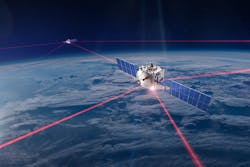Space Development Agency asks industry to build encrypted optical network to link low-Earth-orbit satellites
WASHINGTON – U.S. satellite communications (SATCOM) experts are asking industry to develop a small, lightweight, and low-power encrypted mesh optical network to link satellites in low-Earth orbit.
Officials of the U.S. Space Development Agency (SDA) in Washington issued a Small Business Innovation Research (SBIR) opportunity (HQ085021S0001-05) on Friday for the Mesh Network NSA Certifiable Cryptographic Solution project.
The mesh network cryptographic solution for Optical Inter-satellite Links (OISL) in low earth orbit (LEO) will be low size, weight, and power (SWaP), and demonstrate an automated initial encryption handshake using National Security Agency (NSA) test keys, maintain encryption link, and encrypt and decrypt data with a throughput of 50 gigabits per second per channel, with a minimum of six channels.
The mesh network cryptographic solution must prove technical feasibility during the program's first phase, and the second phase will deliver hardware and software, and functional hardware in its third phase.
The encrypted mesh network must operate in austere environments, and must be small, lightweight, and power-efficient enough for small satellites, and demonstrate the ability to obtain NSA certification.
Companies chosen will develop an easy-to-use SATCOM mesh network that can pass encrypted data at least as fast as 50 gigabits per second per channel. Modem latency must be no more than 15 milliseconds, with five milliseconds preferred.
The project must address interoperability, key management, sustainability, standardization, flexible security, and operational management; operate with legacy cryptographic equipment and several levels of security; support over-the-network-keying with an automated ability to process proper key loads; support automated error handling and recovery; must be able to store and implement several algorithms; and be able to support network defense to include an audit capability.
Companies interested should submit full proposals no later than 31 March 2021 to the DOD SBIR/STTR Innovation Portal (DSIP) at www.dodsbirsttr.mil/submissions/login.
Submit questions or concerns to the DSIP Topic Q&A module online at www.dodsbirsttr.mil/submissions/login.
More information is online at https://beta.sam.gov/opp/262cd2b6216e4002bdd6b15789d5a73e/view.

John Keller | Editor-in-Chief
John Keller is the Editor-in-Chief, Military & Aerospace Electronics Magazine--provides extensive coverage and analysis of enabling electronics and optoelectronic technologies in military, space and commercial aviation applications. John has been a member of the Military & Aerospace Electronics staff since 1989 and chief editor since 1995.

